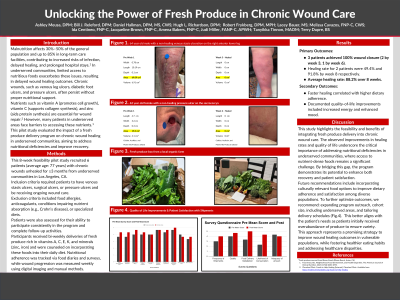Practice Innovations
(PI-029) Unlocking the Power of Fresh Produce in Chronic Wound Care
Friday, May 2, 2025
7:45 PM - 8:45 PM East Coast USA Time

Amena Babers, FNP-C; Lacey Bauer, MS; Jacqueline Brown, FNP-C; Melissa Cavazos, FNP-C, CWS; Ida Centineo, FNP-C; Robert Frykberg, DPM, MPH; Daniel Hallman, DPM, MS, CWS – The Wound Pros; Bill Releford, DPM; Hugh Richardson, DPM
Introduction: Malnutrition affects 30%–50% of the general population and up to 85% in long-term care facilities. Patients with chronic wounds, particularly those with vitamin, mineral, and protein deficiencies, face increased risks of infection, delayed healing, and prolonged hospital stays. Nutrients such as vitamin A (cell growth), vitamin C (collagen synthesis), and zinc (protein synthesis) are critical for wound repair. However, underserved communities with limited access to nutritious foods often experience poor healing outcomes. This pilot study evaluated the impact of a fresh produce delivery program on wound healing in underserved patients with chronic wounds.
Methods: This 8-week feasibility pilot study recruited 6 patients (average age: 77 years) with chronic wounds unhealed for ≥3 months from underserved communities in Los Angeles, CA. Inclusion criteria required patients to have a chronic open wound and receive ongoing wound care. Exclusion criteria included food allergies, anticoagulant therapy, conditions impairing nutrient absorption (e.g., Crohn’s disease), or specialized diets.
Participants received bi-weekly deliveries of fresh produce rich in vitamins A, C, E, K, and minerals (zinc, iron) and were counseled on incorporating these foods into their daily diet. Nutritional adherence was tracked via food diaries and surveys, while wound progression was measured weekly using digital imaging and manual methods.
Results: Primary Outcomes:
3 patients achieved 100% wound closure (2 by week 3, 1 by week 6).
2 patients achieved 49.4% and 91.8% healing by week 8, respectively.
Average healing rate: 88.2% over 8 weeks.
Secondary Outcomes:
Faster healing correlated with higher dietary adherence.
Quality-of-life improvements included increased energy and enhanced mood.
Discussion: This study highlights the feasibility and benefits of integrating fresh produce delivery into chronic wound care. Improved healing rates and quality of life underscore the importance of addressing nutritional deficiencies in underserved communities. Future recommendations include adding culturally relevant foods, expanding program outreach, cohort size, and tailoring delivery to patient needs. This approach represents a promising strategy to improve wound healing outcomes in vulnerable populations.
Methods: This 8-week feasibility pilot study recruited 6 patients (average age: 77 years) with chronic wounds unhealed for ≥3 months from underserved communities in Los Angeles, CA. Inclusion criteria required patients to have a chronic open wound and receive ongoing wound care. Exclusion criteria included food allergies, anticoagulant therapy, conditions impairing nutrient absorption (e.g., Crohn’s disease), or specialized diets.
Participants received bi-weekly deliveries of fresh produce rich in vitamins A, C, E, K, and minerals (zinc, iron) and were counseled on incorporating these foods into their daily diet. Nutritional adherence was tracked via food diaries and surveys, while wound progression was measured weekly using digital imaging and manual methods.
Results: Primary Outcomes:
3 patients achieved 100% wound closure (2 by week 3, 1 by week 6).
2 patients achieved 49.4% and 91.8% healing by week 8, respectively.
Average healing rate: 88.2% over 8 weeks.
Secondary Outcomes:
Faster healing correlated with higher dietary adherence.
Quality-of-life improvements included increased energy and enhanced mood.
Discussion: This study highlights the feasibility and benefits of integrating fresh produce delivery into chronic wound care. Improved healing rates and quality of life underscore the importance of addressing nutritional deficiencies in underserved communities. Future recommendations include adding culturally relevant foods, expanding program outreach, cohort size, and tailoring delivery to patient needs. This approach represents a promising strategy to improve wound healing outcomes in vulnerable populations.

.jpg)